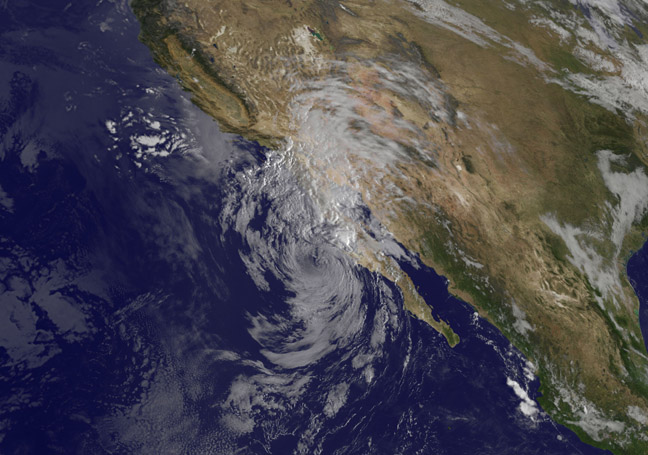Satellite Sees Tropical Storm Simon Over Baja California

NOAA's GOES-West satellite took a visible picture of Tropical Storm Simon on Oct. 7 at 10:45 a.m. EDT. The image showed Simon's clouds over Baja California and northwestern mainland Mexico. Image Credit: NASA/NOAA GOES Project
On Oct. 7, a Tropical Storm Watch was in effect for Punta Abreojos to Punta Eugenia, Mexico. The National Hurricane Center expects Simon to produce storm total rainfall amounts of 3 to 5 inches with isolated amounts around 8 inches through Wednesday, Oct. 8, across northern portions of the Baja California Peninsula and the state of Sonora in northwestern Mexico. Over the next few days, storm total rainfall amounts of 1 to 2 inches with isolated amounts of around 4 inches are expected across portions of Arizona. This rainfall could cause flash flooding and mud slides.
In addition, winds to tropical storm force are still possible within the Watch area today. Simon continues to generate large swells that will affect portions of the Baja California Peninsula and the coast of southern California today. These swells are likely to cause life-threatening surf and rip current conditions.
NOAA's GOES-West satellite took a visible picture of Tropical Storm Simon on Oct. 7 at 1445 UTC (10:45 a.m. EDT). The image was created by the NASA/NOAA GOES Project at NASA's Goddard Space Flight Center in Greenbelt, Maryland. The image showed Simon's clouds over Baja California and northwestern mainland Mexico. Simon's northernmost clouds stretched into the U.S. southwest. Despite its large appearance, during the morning of Oct. 7, only small area of showers were showing on radar near the north-central Baja California peninsula.
At 11 a.m. EDT (1500 UTC) on Oct. 7, Simon's maximum sustained winds were down to 40 mph (65 kph) and weakening. The center of Tropical Storm Simon was located near latitude 27.7 north and longitude 116.7 west. That's about 100 miles (160 km) west of Punta Eugenia, Mexico. Simon is moving toward the north-northeast near 9 mph (15 kph) and this general motion is expected to continue for the next 24 to 36 hours.
The National Hurricane Center expects Simon to continue weakening and become a remnant low pressure area by Oct. 8. NHC noted that “Simon's surface circulation or its remnant low pressure area is likely to dissipate while it moves into the southwestern United States, unless it fails to survive its passage over the mountainous Baja peninsula during the next day or so.”
Rob Gutro
NASA's Goddard Space Flight Center
Media Contact
All latest news from the category: Earth Sciences
Earth Sciences (also referred to as Geosciences), which deals with basic issues surrounding our planet, plays a vital role in the area of energy and raw materials supply.
Earth Sciences comprises subjects such as geology, geography, geological informatics, paleontology, mineralogy, petrography, crystallography, geophysics, geodesy, glaciology, cartography, photogrammetry, meteorology and seismology, early-warning systems, earthquake research and polar research.
Newest articles

Superradiant atoms could push the boundaries of how precisely time can be measured
Superradiant atoms can help us measure time more precisely than ever. In a new study, researchers from the University of Copenhagen present a new method for measuring the time interval,…

Ion thermoelectric conversion devices for near room temperature
The electrode sheet of the thermoelectric device consists of ionic hydrogel, which is sandwiched between the electrodes to form, and the Prussian blue on the electrode undergoes a redox reaction…

Zap Energy achieves 37-million-degree temperatures in a compact device
New publication reports record electron temperatures for a small-scale, sheared-flow-stabilized Z-pinch fusion device. In the nine decades since humans first produced fusion reactions, only a few fusion technologies have demonstrated…





















